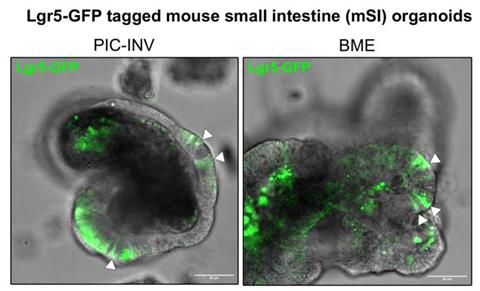Researchers from the Hubrecht Institute and Radboud University have developed a completely animal-free gel to grow organoids, miniature three dimensional versions of organs.

By combining the bacterial protein invasin with a synthetic gel known as polyisocyanopeptide (PIC), they created an environment in which organoids can grow and expand long-term, just as they do in animal-derived gels such as Matrigel. The study, published in PNAS, marks the first synthetic and animal-free system that enables long-term growth of 3D organoids.
READ MORE: Bacteria to the rescue: a sustainable solution for growing organoids
READ MORE: Scientists culture previously uncultivable human rhinovirus C with innovative respiratory organoids
In 2024, researchers in the Clevers group showed that invasin could be used to grow organoids in 2D on flat surfaces, an approach ideal for large-scale screening and drug testing. Now, the team shows that combinding invasin with PIC gel allows organoids to grow in 3D, just like they do in animal-derived gels such as Matrigel and BME. PIC gel was originally developed at Radboud University.
“The 2D system is great for high-throughput applications,” says group leader Hans Clevers. “The 3D system is complementary to that, for instance to study how tissues develop and function.”
Fully synthetic alternative
Until now, most organoid research relied on Matrigel or BME, gels made from mouse tumors. While effective, these materials are expensive, variable between batches, and depend on animal sources. The new PIC–invasin gel overcomes all of these limitations.
The gel is completely synthetic and animal-free, highly standardized, and likely more cost-effective once production is scaled up. It also offers the same optical transparency as Matrigel, allowing researchers to observe the 3D organoids directly under the microscope.
Moreover, the gel is user-friendly: it remains liquid when cold, solidifies into a gel at body temperature (37 °C), and turns back into a liquid when cooled again. This reversible behavior makes the gel easy to work with in the lab.
Long-term growth
Crucially, the team demonstrated that organoids grown in the PIC–invasin gel can be expanded continuously over long periods of time, while maintaining the same structure and cell types as organoids grown in animal-derived gels.
Organoids from a variety of human and mouse tissues grew successfully in the PIC–invasin gel, showing its robustness and potential for widespread use in both research and clinical settings.
By replacing animal-derived materials with a fully synthetic alternative, this study represents a major step toward more ethical and reproducible biomedical research. The PIC–invasin gel could also accelerate regenerative medicine efforts, where the ability to grow large amounts of healthy tissue is essential.
Exciting possibilities
“This breakthrough makes organoid research more consistent, ethical, and affordable,” says Joost Wijnakker, first author of the study. “It opens up exciting possibilities for drug testing, tissue transplantation, and fundamental studies of human biology, all without relying on animal products.”
This research is a collaboration between the Hubrecht Institute and Radboud University and is part of the Materials-Driven Regeneration Research Center.







No comments yet